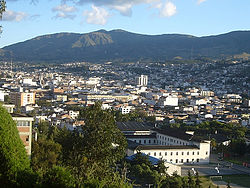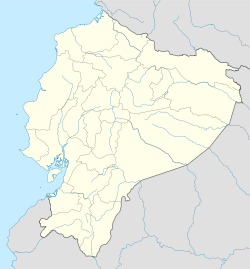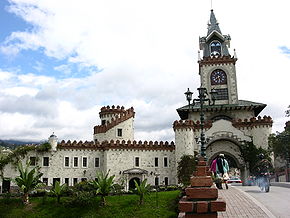- Loja, Ecuador
-
This article is about the city. For the province, see Loja Province. For the canton, see Loja (canton). For other places named Loja, see Loja (disambiguation).
Loja 
Flag
SealNickname(s): "Musical Capital of Ecuador" Motto: Loja Para Todos (Loja is for Everyone) Coordinates: 3°59′S 79°12′W / 3.983°S 79.2°WCoordinates: 3°59′S 79°12′W / 3.983°S 79.2°W Country Ecuador Province Loja Canton Loja Founded December 8, 1548 Government – Mayor Jorge Bailon Area – City 1,883 km2 (727 sq mi) Elevation 2,100 m (6,889 ft) Population (2010) – City 185,000 – Metro 215,077 Time zone ECT (UTC-5) Website www.loja.gov.ec/ (Spanish) Loja (full form: Ciudad de la Inmaculada Concepción de Loja) is the capital of Ecuador's Loja Province. It is located in the Cuxibamba valley in the south of the country, sharing borders with the provinces of Zamora-Chinchipe and El Oro, and with Peru in the south. Loja holds a rich tradition in the arts, and for this reason is known as the Music and Cultural Capital of Ecuador. The city is home to two major universities.
The city has a population of about 200,000, and is situated 2100 m (6890 ft) above sea level. It has a mild Andean climate, ranging between 16 and 30°C.
The Pan-American Highway runs past Loja.
Contents
History
The city of Loja was founded by Field Marshal Alonso de Mercadillo in 1548, and it is named for his hometown of Loja in Spain. Originally located near La Toma in the Catamayo canyon, the city was relocated to its present location (about 35 km east) after a devastating earthquake. At nearly 500 years, it is one of the oldest cities in Ecuador. The city was also visited by Simón Bolívar in his campaign to unite Gran Colombia.
Loja was a departure point for the Amazon Basin and the El Dorado region for Spanish Conquistadors. It declared its independence from Spain on November 18, 1820.
The city of Loja has the distinction of being the first city in Ecuador to be wired for electric power provided by a hydroelectric dam that was completed in the 1890s.
Geography
Loja is in the bottom of the broad glacial Cuxibamba valley. It lies between the humid Amazon Basin and the Peruvian sechura, and is composed mainly of paramo, cloud-forest, and jungle. The valley borders the Podocarpus National Park, which is a massive cloud-forest reserve accessible through the Cajanuma gates just minutes outside the city. The Rio Zamora and Rio Malacatos flow through the city of Loja.
Climate
Loja has a mild Andean climate, generally warm during the days and colder and often wetter at night. The average temperature is 16 °C (61 °F). June and July brings an eastern drizzle with the trade winds, and is referred to as the "windy season." Due to its valley location, the city is often misty in the morning with general absence of sunshine, clearing off towards the afternoon.
Climate data for Loja, Ecuador Month Jan Feb Mar Apr May Jun Jul Aug Sep Oct Nov Dec Year Average high °C (°F) 23
(73)22
(72)23
(73)23
(73)23
(73)22
(72)22
(72)22
(72)23
(73)24
(75)24
(75)24
(75)22.9
(73.3)Average low °C (°F) 8
(46)8
(46)7
(45)8
(46)7
(45)7
(45)7
(45)6
(43)7
(45)6
(43)5
(41)6
(43)6.8
(44.3)Rainfall mm (inches) 91.8
(3.614)113.1
(4.453)126.9
(4.996)87.8
(3.457)55.3
(2.177)57.0
(2.244)57.7
(2.272)47.1
(1.854)47.1
(1.854)72.7
(2.862)58.7
(2.311)77.3
(3.043)892.5
(35.138)Avg. rainy days (≥ 1.0 mm) 14 15 16 13 11 10 10 9 8 11 8 11 136 Sunshine hours 124 113 124 120 155 150 155 155 150 155 180 155 1,736 Source no. 1: Loja Climate Guide[1] Source no. 2: Climatological normals of Loja (rainfall and rain days)[2] Economy
Arts and culture
There is a thriving musical scene in Loja, in keeping with the city's reputation. There are numerous small music and salsa clubs, and it is not uncommon to hear Lojanos singing as they go about their day. On Sundays, the local police band performs in the Plaza de Independencia outside of San Sebastian Church.
The city is full of public artworks, including massive painted tile murals, frescoes, and statuary. Of particular note are the frescoes of Bolívar and Sucre that greet visitors as they pass through the gates of the city.
Annual cultural events
- May 30 - August 15 - Pilgirmage of the Virgin of El Cisne
- June 25 - Foundation of Loja Province
- September 1–15 - Ecuador-Peru Border Integration Fair
- November 1 - Return of the Virgin of Cisne to the town of El Cisne
- November 18 - Independence of Loja
- December 8 - Foundation of Loja
Museums
- Central Bank Museum
Located in downtown Loja, just off the central square, is the Central Bank Museum. It contains the archaeological, historical, and colonial history of the province and city of Loja. There are seven rooms in the museum, each detailing a different aspect of the area: the entrance hall, archaeology, nature, the colonial period, the 19th century, the important people of Loja, and arts and crafts.
- Museum of Madres Conceptas
This is housed in a 16-17th century convent, belonging to the colonial period. The museum preserves its images, domestic utensils, and instruments used by the nuns for self-flagellation. It also houses a collection of colonial religious artwork.
- Museum of Archaeology
Opened in 2004, the Museum of Archaeology houses some 1,600 artifacts, many of which are from the Pre-Columbian period. There are three floors to the museum, organized by the age of the artifacts. The first floor houses Paleolithic and Neolithic artifacts and remnants of the Valdivia Culture. The second floor contains artifacts of the Tolita, Jamas Coaque, Bahía, and Guajala cultures. The third floor showcases articles from the Charchi, Imbabura, Panzaleo, Puruhuá, Casholoma, Tacalshapa, Manteña, Tardia, Milagro, Quevedo, Huancavilca, and Inca.
- Musical Museum of the Pio Jaramillo Alvarado Cultural Center
Situated on Av. Valdivieso and opened in 2004 the museum houses exhibits on the composers and musical history of Loja, from the Renaissance to the avante-garde. The collection spans nearly 200 years of history, with more than 7,000 musical scores and 65 instruments on display.
- Matilde Hidalgo de Procel Museum
The museum, on the main floor of the Loja Provincial Government building, houses artifacts from the life of Matilde Hidalgo, the first woman to become a medical doctor in Ecuador, and also the first woman to vote in Latin America.
Points of interest
- Puerta de la Ciudad
The gates of the city are modeled after the Coat of Arms of the city, presented by King Felipe II of Spain in 1571. The gate is on Av. Gran Colombia, and houses four galleries which show contemporary Lojano artwork, and a cafeteria and gift shop. A stunning view of the city is found by climbing the clock tower. Loja contains a number of historic churches; the city's board of tourism has approached finding them in a novel manner. Beginning at the Puerta de la Ciudad, one of the first thing a tourist will notice is a large orange stripe painted on the sidewalk. Following the stripe takes the interested on a self-guided tour of the main historic churches and areas of Loja.
- Cathedral
The main Cathedral, a masterpiece in the colonial style, is located on the central square. It is home for six months of the year to the Virgin of Cisne, whose statue is carried on the backs of the faithful to and from the town of Cisne, 45 km north of Loja. The procession shuts the road to traffic twice a year, and it is a mark of pride among Lojanos to participate. Original adobe in the cathedral building dates from the 16th century; the current building dates from 1838 (previous edifices were lost to earthquakes. The Cathedral is one of the largest churches in Ecuador. It is the seat of the Roman Catholic Diocese of Loja.
- Church of San Francisco
The small Church of San Francisco houses the city's Franciscan convent. The church was built in 1548 and then rebuilt in 1851. The plaza, located on the corner of Av. Bolivar and Av. Colon, features a monument to Alonso de Mercadillo, founder of the city.
- Church of Santo Domingo
The Church of Santo Domingo was built in 1557; the entire edifice was once in the Gothic style, but after an earthquake in 1867 only the twin spires remained standing. The church was refinished in the colonial style, but the spires were left as a reminder of the former facade. The church was painted and decorated by notable Lojano Fray Enrique Mideros. In the plaza of the church stands a monument to Manuel Carrión Pinzano, a founder in 1853 of the Federalism movement in Loja.
- Church of San Sebastian
In 1660, the city of Loja was consecrated to St. Sebastian in order to prevent destruction by earthquakes. The present church dates from 1900. Perhaps the most notable landmark of Loja stands on the Plaza San Sebastian (also called the Plaza of Independence) - the 32 meter clock tower commemorates the declaration of independence from the Spanish Crown on November 18, 1820. The tower has four faces with brass bas relief depicting scenes from the city's history.
- Monuments
There are numerous other monuments to famous Lojanos and Ecuadorians. Central Square contains the monument to Bernardo Valdivieso, the founder of Loja's universities; a monument to Bolívar is housed in a park of the same name to commemorate his visit to Loja in October 1822. A monument to Pío Jaramillo stands on the south end of the avenue bearing his name, and at the junction of Av. Jaramillo and Av. Carrión stands a monument to Benjamin Carrion. A monument to Isidro Ayora stands in the roundabout in front of the bus terminal. For more information on these and other historic Loja residents, see the section on notable natives and residents.
Sports
The city is home of Liga de Loja, a major football team that plays in the Ecuadorian professional football league.
Parks and recreation
There are three parks of note inside the city, and a botanical garden just outside the city limits.
- Jipiro
In the north of the city, Jipiro Park covers more than 10 hectares and is notable for its scale reproductions of historic and cultural buildings. The park boasts a pagoda, mosque, St. Basil's cathedral, a medieval castle, and many more, as well as a lake for paddle-boating with an island aviary.
- La Banda Park
Next to Jipiro on the eastern and western shores of the Rio Zamora, is a huge greenspace with a public carting race track, riding trails, an orchid nursery, and the Loja zoo.
- Parque Pucará de Podocarpus
On a hill called Pucará de Podocarpus, this is a children's park with playground equipment and a beautiful scenic view. It is located on the city's former drinking water treatment plant.
- Reynaldo Espinoza Botanical Garden
Just 5 km outside of Loja and belonging to the National University, are 4 hectares of plants native to the provinces of Loja, Zamora Chinchipe, and El Oro. Most of the trees in this garden are over 40 years old, and the park is one of the world's highest-altitude botanical gardens.
Education
Loja has some of the top Universities in Ecuador the Universidad Técnica Particular de Loja is one of the top 3 in the nation, offers local and distance education in different fields such as Architecture,Medicine, Communications,Law Accounting,Enginierring Auditing,Electronics and Telecommunications, Trades, Administration, Humanities, Biology and many more. In September of 2007, the UTPL adopted an academic model based on the European System of Credit Transfer and Accumulation (ECTS), which assesses the student’s workload, in order to achieve the objectives of an academic program which are reflected in learning achievements and acquired competences. This University has partnership programas with many universities around the world such as Universidad San Diego California, Berkerly College, Universidad de Frankfurt, Technische Universität München, The Chinese University of Hong Kong, Universidad de Buenos Aires and many other top universities around the globe. In addition the U.T.P.L has three international campus, besides the principal one in Loja, Ecuador. They are located in New York,(Usa) Madrid, (Spain) and Rome, (Italy).
Another notable school, top 10th in the nation, is the Universidad Nacional de Loja, which offers programs in Law, Aperture Science, Education, Medicine, Veterinary sciences, Business, Science and Technology, and Fine Arts. The Loja campus of the Universidad Internacional del Ecuador, in partnership with Harvard University, and the International University of Florida, offers Business Engineering, Finance, Marketing, Ecotourism, Foreign Trade, Economics, Law, Industrial Design, and Interior Design. Finally, the Universidad Técnica Particular de Loja offers local and distance education in Trades, Administration, Humanities, and Biology.
Transportation
Streets are laid out on a grid system, and named for notable Ecuadorians and city founding dates. Paved walkways frame the two rivers and provide easy access north and south through the city. There are several bus lines running in the city, and also many cabs. However, unless it is for great distances, people walk. There is a bus station at the north end of the city, with routes connecting to the rest of Ecuador, and into Peru. Loja is served by La Toma airport in Catamayo, 45 km (28 mi) distant. From there, it is possible to fly to Quito or Guayaquil. La Toma is served by Tame and SAEREO airlines.
Media
The major newspaper is La Hora,[3] and the Quito and Guayaquil dailies are also available here.
Notable natives and residents
- Alonso de Mercadillo - founder of Loja in 1548.
- Pío Jaramillo Alvarado - an illustrious writer, sociologist, historian, journalist, and internationalist, who dedicated his life to elevating national literature
- Alejandro Carrión - prolific writer and journalist
- Benjamín Carrión - founder of the Ecuadorian "Casa de la Cultura" and writer
- Manuel Carrion Pinzano - originator of the federalist movement in Loja in 1853
- Bernardo Valdivieso - benefactor of Loja's universities and defender of religious principles
- Isidro Ayora - President of Ecuador 1926-1931
- Eduardo Kingman - one of the originators of the indigenista movement in Ecuadorian art, and teacher of Guayasamín. Considered one of Ecuador's greatest artists of the 20th century.
Other topics
Loja is regarded as a seat of Ecuadorian culture. A local saying is: "The one who does not play the guitar can sing a song; the one who does not sing a song can write a verse; the one who does not write a verse reads a book."
Just outside of Loja are the valleys of Vilcabamba and Malacatos.
See also
Loja Province
Loja (canton)
Loja airportReferences
- ^ "Loja Climate Guide". http://www.worldclimateguide.co.uk/climateguides/ecuador/loja.php. Retrieved 3 November 2011.
- ^ "Climatological Information for Loja, Ecuador". http://www.hko.gov.hk/wxinfo/climat/world/eng/s_america/ec_per/loja_e.htm. Retrieved 3 November 2011.
- ^ Diario La Hora - Noticias de Ecuador y el Mundo
- http://www.lojanos.com/ Lojanos.com - Virtual Community of Loja
- Guia de la Provincia de Loja, Ministerio de Turismo Ecuador, Quito, 2007
- Loja Para Todos, Camara de Turismo de la Provincia de Loja, Loja, 2007
- Historia Corta del Ciudad de Loja, various authors, UTPL, Loja, 2007
External links
- Loja Area Map
- http://www.lojanos.com/ (Spanish) Lojanos.com - Virtual community of Loja (Spanish)
- Official page of Loja municipality (Spanish)
- "Official website of the National Shrine of Our Lady of El Cisne". http://www.santuariodelcisne.org. Retrieved 2008-12-21.
Provincial capitals in Ecuador Within regions, north to southInsular Costa Sierra Oriente Categories:- Populated places in Loja Province
- Populated places established in 1548
- Province capitals in Ecuador
Wikimedia Foundation. 2010.





